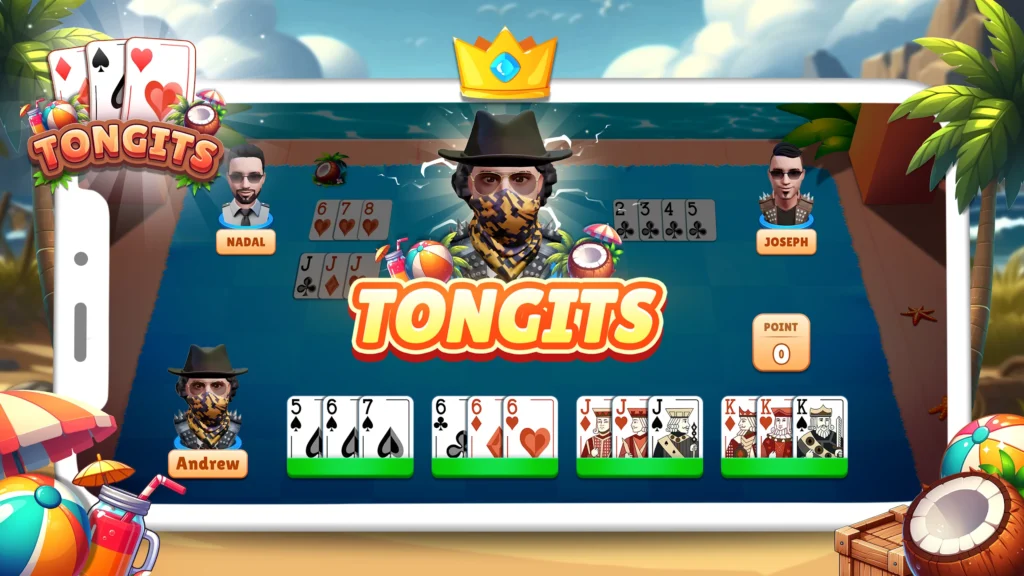About this game
Dive into the Classic Filipino Card Game: Tongits
Tongits is a beloved Filipino card game that combines strategy and skill, offering endless entertainment for players of all ages. Perfect for those who enjoy a mental challenge and social interaction, Tongits has now been brought to the digital world, allowing you to enjoy this classic game anytime, anywhere.



How to Play Tong-its?
Tong-its is played using the standard Anglo-American pattern 52-card deck. Unlike many Rummy variations, Tong-its does not make use of the Jokers sometimes available.
Tong-its is exclusively a three-player game, something which makes it unique among the Rummy-family. The odd number of Players, as well as the inability to add or subtract Players from the game, makes for an interesting deal as well. This short tutorial will explain the basic concepts of the game.
The Deal
The initial deal gives 12 cards to both non-dealing Players, but 13 to the Dealer. Due to this interesting arrangement, the Dealer should be decided by random means.
Either a dice should be rolled, with the highest roll determining the Dealer, or cards should be drawn from the deck, with the highest ranked card determining the Dealer. Ties would naturally take a second roll, or draw a second card.
Once the Dealer is chosen, they will then deal out the cards in the fashion described above. Like in other Rummy games, the remaining cards in the deck are then placed in the center of the play area. These cards are known as the “stock”, and will serve as a reservoir for drawing more cards if needed.
The game is officially considered started when the Dealer discards one of their 13 cards, creating the first card of the “discard” pile. The Dealer’s first turn then ends, with the Dealer unable to meld or discard, and the Player counterclockwise to the Dealer will begin their first turn.
Melds will be explained below in the “Card Combinations” section.
The Game
At the start and end of each Player’s turn, they must draw one card from the stock and discard one card to the discard pile respectively.
From this point on, the Players and the Dealer will make melds and sets.
- A set is merely adding cards onto an existing meld that is already on the board.
- Melds are specific collections of cards, like the popular hands of Poker.
Each card in Tong-Its is associated with a particular point value, these point values are assigned to a Player’s total only at the end of the game with cards that are still in their hand.
Ending the Game
Tong-its can end for the purposes of tallying point values in multiple different ways.
Stock-out
One such way is known as the “stock-out.” In a stock-out situation, all of the cards in the stock have been drawn. When this happens, the game automatically ends once it is drawn. This means the last Player to draw will not be able to play melds or sets on that turn.
Tung-it
There is also the “Tung-it” itself. When a Player’s hand is completely empty, they may declare “Tung-it” immediately after they place down their last card. This is an automatic victory for the Player who declares Tung-it, as their point value for the tally will be 0.
Draw
The “Draw” is another way to end the game. The name does not necessarily mean that the game will draw, only that it is possible.
To Draw, the Player who believes they have the lowest value of cards may declare Draw. Draw may be declared at any time, though it is bad etiquette to do so at the beginning of the game unless it is a Double Hit.
When Draw is declared, the other Players may either concede that they likely have higher card totals by folding, or they may challenge the Draw, and each Player will tally their points. The Winner of the challenge will then be, as normal, the Player with the lowest point total.
A Player may not challenge a Draw unless they have played at least one meld, or they must hold the “secret”, a four-of-a-kind or set of all four cards of a particular rank. If they hold the secret, they may declare a challenge to the Draw.
A Player that cannot challenge a draw due to lacking any melds on the board, or the four-of-a-kind, is considered “Burned”. A Burned Player may also not win in the case of a stock-out, even if they have the lowest point total.
Double Hit
There is also the Double Hit, a game mechanic drawn from Mahjong.
If a Player, at the start of the game after the Dealer has discarded, is able to meld and set their entire 12-card hand, without drawing or discarding, they are considered “Double Hit.” The Player instantly wins the game, and any wager that might be owed to that Player is then paid to them immediately.
Games of Tong-its can be played in sets of two, where one whole “match” is two games of play, with the winner of the whole match being the lowest scorer in the overall match. In this case, the round in which a Player won the game by Tong-it, or Double Hit, will have their score for that round be listed as 0.
Tong-its Rules
- Do not declare Draw at the start of the game, without playing any melds or sets. This is considered rude and against the unofficial rules. Furthermore, Draw may only be declared when it is your turn.
- A card must be drawn at the start of each Player’s turn, and a card must be discarded at the end of each Player’s turn. This is always true, unless a Player has ended the game without discarding on their turn.
- The Dealer is considered a “Player” once the game has begun.
- Players may set or meld as many times as they are able on their own turn. They may not set or meld during other Player’s turns.
- Unlike other Rummy variations, there are no wild cards in Tong-its.
- Aces are high and low for melds, but are only worth 1 point in the hand at the end of the game. This makes Aces low-risk, versatile cards.
Scoring & Points
To tally the score at the end of the game, each card in Tong-its is assigned a particular value. The chart below will explain the value of each card.
| CARD | SCORE |
|---|---|
| K, Q, J, 10 | 10 Points |
| 9 | 9 Points |
| 8 | 8 Points |
| 7 | 7 Points |
| 6 | 6 Points |
| 5 | 5 Points |
| 4 | 4 Points |
| 3 | 3 Points |
| 2 | 2 Points |
| Ace | 1 Point |
At the end of the game, all the cards in your hand will have their associated point totals tallied up. Normally, they will only be tallied up if a Draw is Challenged, unless it is a 2-round game in which case tallies will always be taken.
Card Combinations
There are 4 melds in Tong-its. Melds or “Bahay” are card combinations or specific groupings of cards that meet specific requirements. These are:
The Three of a Kind
Three cards of the same Rank. All 7s, or All Kings for example.
Four of a Kind
Four cards of the same rank, or all of that copy of the card in the deck. For example, all the Ace from each suit (♥♦♣♠)
Sagasa
The Sagasa is a Four of a Kind that’s formed from a setting on a Three of a Kind. The Player that melded the Three of a Kind must set the fourth card, creating a Sagasa. Otherwise, it is not Sagasa, but merely a set on the end of a Meld.
The Straight Flush
Like in Poker, the Straight Flush is a sequence of cards that are all the same suit, for example: 7, 8, 9, 10, J, with each card being a ♠.
Aside from these melds, Players may also “set” cards on top of melds that another Player has created. A card may be placed on either end of the set, so long as it is legal to play.
For example, a Player might add a 6♠ or a Q♠ to the Straight flush above. Players may set as many cards as they are legally able within a turn.
Strategy & Tips
- There are no wild cards, so in order to make a meld you must have every copy of the required meld.
- Setting relies on your opponents, and only setting without melding can lead to being Burned. Try to get your first meld out as quickly as possible.
- Since a card must be drawn at the start of each turn, a game of Tong can last for no longer than 17 hands. Divided by three, this means you will only have 7 or 8 turns in which to try and empty your hand before Stock-Out occurs.
- Holding onto a Secret, or a complete Four of a Kind in your hand, can be a good trap against Players who frequently declare Draw. This Secret will bait them into declaring Draw, while you will be allowed to play those cards before the tally, making your hand seem bigger than it is when they declare Draw.

